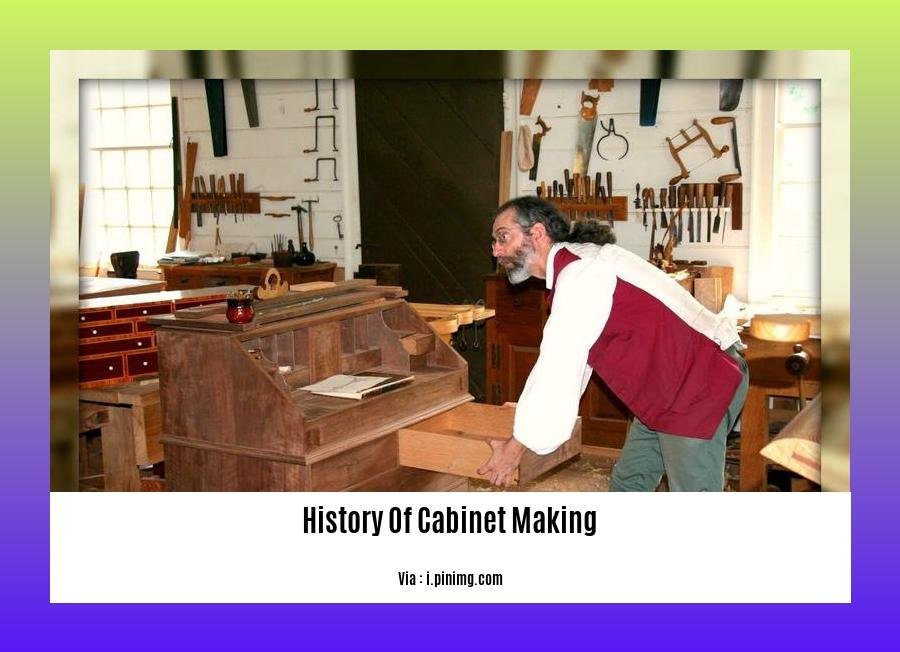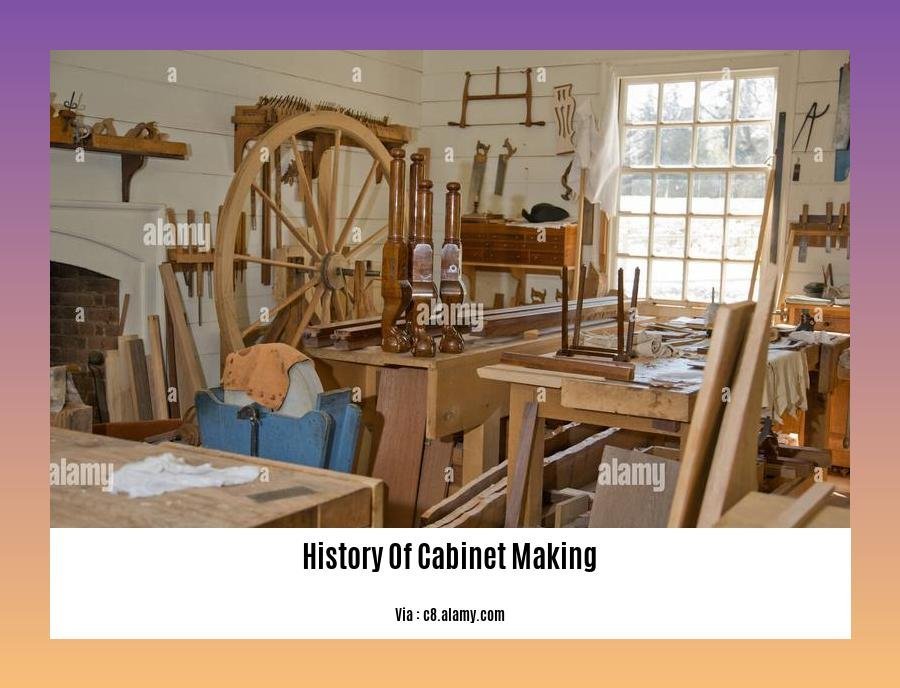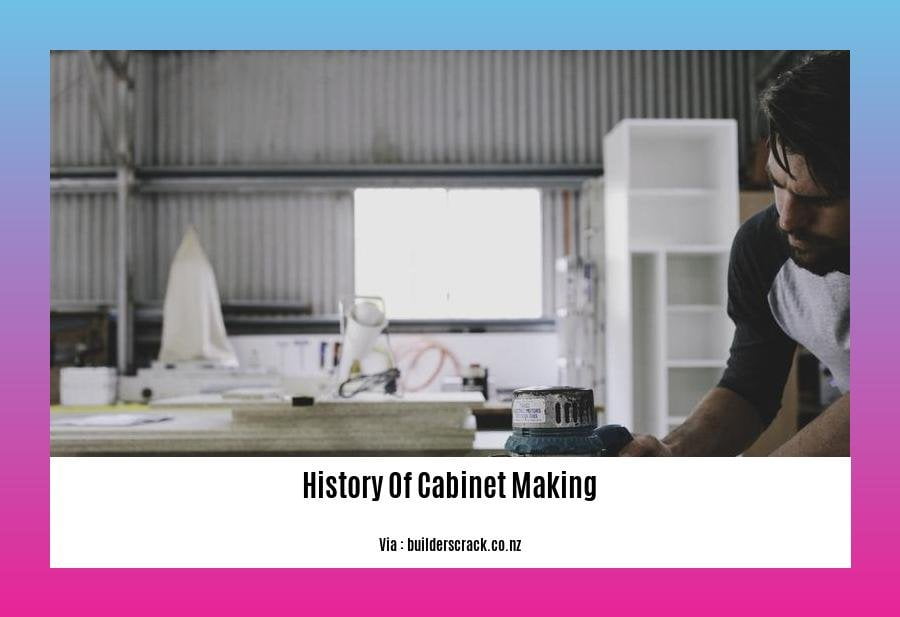Embark on a captivating journey through the annals of cabinet making, where skill and artistry intertwine to create timeless masterpieces. From the artisanal traditions of the past to the advancements of the Industrial Revolution, this historical account explores the evolution of this cherished craft. Witness the introduction of power tools and the transformation of cabinet making training, shaping the path towards the exquisite furniture we admire today.
Key Takeaways:
- Definition: Cabinets are storage units with shelves and/or drawers, used for storage or display.
- History: Cabinet making was a specialized trade before industrialization, but mass production techniques shifted production away from traditional shops.
- Schools of Design: Glamour style combines elements from various historical periods.
- Kitchen Cabinetry: Designs and construction vary geographically, with specific standard heights for lower and upper cabinets.
- Importance: Cabinetry provides storage, display, and complements interior design.
History Of Cabinet Making


Cabinet making, an art form characterized by the creation of functional and aesthetically pleasing storage units, has a rich and captivating history spanning centuries. Join us as we delve into the intriguing journey of cabinet making, exploring its origins, evolution, and significance.
Humble Beginnings: The Genesis of Cabinets
The concept of cabinets can be traced back to ancient civilizations, where rudimentary storage units were crafted from natural materials like wood and stone. These early cabinets served practical purposes, offering protection and organization for belongings.
Master Craftsmen: The Golden Age of Cabinetry
During the Renaissance and Baroque periods, cabinet making flourished as a respected craft. Skilled artisans honed their techniques, creating elaborate and ornate cabinets that became symbols of wealth and status. These master craftsmen employed intricate carvings, fine joinery, and luxurious materials, leaving an enduring legacy of craftsmanship.
Industrial Revolution: A Paradigm Shift
The advent of the industrial revolution brought about profound changes in cabinet making. Steam-powered machinery facilitated mass production, enabling the creation of cabinets on a larger scale. While this transition led to increased efficiency, it also marked a departure from the bespoke, handcrafted approach that had defined the craft for centuries.
Modern Cabinetry: Embracing Innovation
In the 20th century, the rise of modernism influenced cabinet design. Clean lines, simplicity, and functionality became the guiding principles. New materials, such as plywood and laminates, introduced greater affordability and versatility. Today, cabinet making continues to evolve, embracing technological advancements while honoring traditional techniques.
Conclusion
The history of cabinet making is a testament to the enduring human desire for functional and aesthetically pleasing storage solutions. From humble beginnings to the heights of craftsmanship and the transformative power of industrialization, this craft has played an integral role in shaping our homes and living spaces. Cabinet making remains an art form that combines tradition with innovation, preserving the legacy of skilled artisans while adapting to the needs of modern living.
If you’re curious about the intriguing evolution of furniture storage, delve into the fascinating History Of Cabinets. Step into the world of photography’s early years by exploring the History Of Cabinet Cards and discover the formation of governing bodies in the History Of Cabinet Departments.
,
Cabinet Making Post-World War 2
Following the devastation of World War II, the world entered a period of rebuilding and renewal. The demand for housing and furnishings soared, and Cabinet Making played a vital role in this post-war reconstruction.
Revival of Traditional Craftsmanship
With the return of soldiers from the war, traditional woodworking skills were revived. Many veterans brought back an appreciation for the craftsmanship they had witnessed during their service, particularly in Europe. This led to a renewed interest in classic cabinet making techniques, such as dovetail joinery and hand-carving.
Adoption of New Materials and Technologies
The post-war era also saw the emergence of new materials and technologies that transformed Cabinet Making. The availability of plywood, laminates, and plastics allowed for the production of more affordable and durable cabinets. The widespread use of power tools, such as routers and electric saws, also increased efficiency and precision in the construction of cabinetry.
Modernist Designs and Aesthetics
The post-war period witnessed a shift towards modernist design, characterized by clean lines, geometric shapes, and the use of natural materials such as wood and metal. This aesthetic influence extended to cabinetry, as many designers incorporated modernist elements into their designs. The result was a new generation of cabinets that were both functional and stylish.
Mass Production and Standardization
The post-war economic boom and the growing popularity of suburban living led to an increased demand for affordable cabinetry. This demand was met by the development of mass production techniques and the standardization of cabinet sizes and components. While this made cabinetry more accessible to the masses, it also resulted in a decline in custom-made pieces.
Key Takeaways:
- Post-war Cabinet Making witnessed a revival of traditional craftsmanship due to the return of veterans.
- New materials and technologies such as plywood and power tools improved efficiency and durability.
- Modernist design influences shaped cabinetry aesthetics, emphasizing clean lines and geometric shapes.
- Mass production and standardization made cabinets more accessible but reduced custom-made options.
Citations:
- Cabinet Making in the Post-World War II Era
- The Evolution of Cabinet Making after World War II
FAQ
Q1: How did the Industrial Revolution impact cabinet making?
A1: The Industrial Revolution introduced power tools, such as steam-powered saws and lathes, which significantly increased production efficiency and transformed cabinet making from a craft-based trade to a more industrialized process.
Q2: What is the role of training in cabinet making?
A2: Formal training is crucial for cabinet makers as it provides them with the technical skills, knowledge of tools and materials, and design principles necessary to create high-quality cabinets.
Q3: How did cabinet making evolve after World War 2?
A3: Post-World War 2, there was a surge in demand for housing and furniture, leading to advancements in cabinet making techniques and the adoption of more efficient production methods, including the use of prefabricated components.
Q4: What are some key skills required for cabinet makers?
A4: Cabinet makers require proficiency in cutting, shaping, and joining wood, as well as the ability to use hand and power tools effectively. They also need a strong understanding of design and planning principles.
Q5: How has cabinet making adapted to changing demands?
A5: Modern cabinet making has adapted to changing consumer preferences, advancements in technology, and sustainability concerns. Cabinet makers now incorporate innovative materials, embrace sustainable practices, and cater to diverse design styles to meet the evolving needs of clients.









